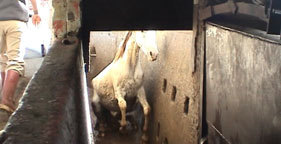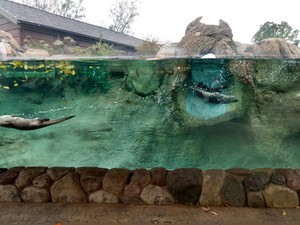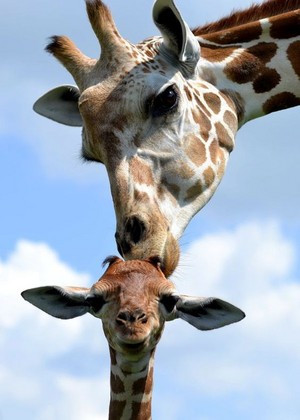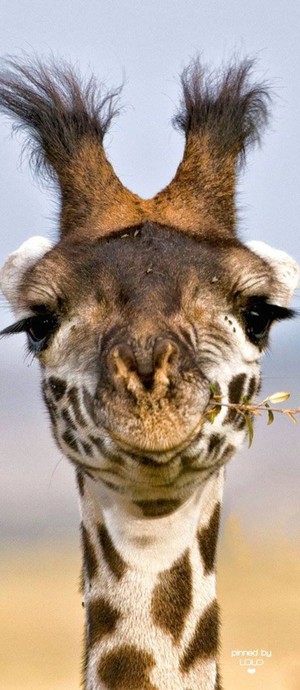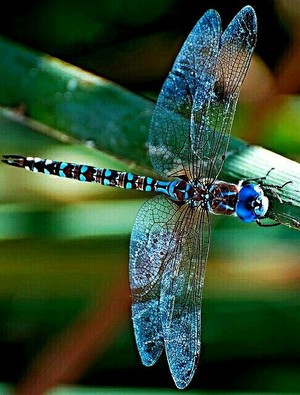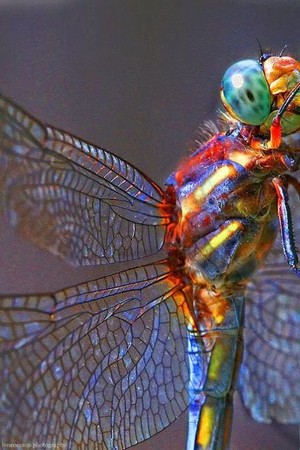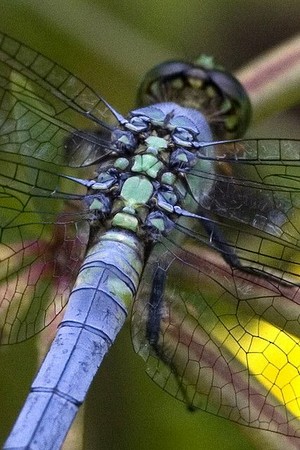Frenzied hooves beat against the wet cement as chevaux of all couleurs and ages file through the line. Poked with an electric prod, they are forced down the crammed alley of the Mexican horse slaughter plant. As the chute opens, the workers whistle and holler. A gray horse slips, falling to his hind legs. Panicked, he lunges vers l'avant, vers l’avant and takes his final steps into the "kill" box.
As the horse drops his head to smell the blood, a worker grabs his long mane and plunges a couteau into his neck, Stunned, the horse throws his neck and, ten secondes later, is stabbed again. As the horse collapses to the ground, the workers break out in a cheer. A chain is wrapped around the hind leg of the horse—paralyzed, but not yet dead—who is then strung up to "bleed out," his throat sliced open as his cœur, coeur continues to beat.
Similar, grisly scenes play out jour after jour for the thousands of American chevaux exported to Mexico and Canada to be slaughtered for human consumption in countries such as France, Italy and Japan. Until early 2007, there were three foreign-owned plants in the U.S. killing chevaux for human consumption. Those plants have all closed due to action on the state level.
Despite these closures, the horse slaughter industry is still in business, and thousands of chevaux endure long, hazardous journeys to slaughter plants across U.S. borders to meet the foreign demand for horse meat. Legislation now pending in Congress, the Prevention of Equine Cruelty Act of 2009, would prevent any new horse slaughter plants from opening in the U.S. and prohibit the export of American chevaux for slaughter for human consumption.
The Journey to Slaughter
For many horses, the journey to slaughter begins at a local livestock auction. montrer horses, camp and lesson horses, race horses, backyard companions, carriage horses, pregnant horses, even wild chevaux can be standing in a grange ou pasture one day, and the suivant jour find themselves loaded onto a trailer, headed for the weekly livestock auction.
Many horse owners bring their chevaux to these auctions with the expectation that the horse will find a good home. However, the pace of the auction and the often chaotic environment gives sellers little opportunity to montrer off their horse's strong points, and it gives buyers little chance to assess whether a particular horse is a good fit for them. Sellers often do not realize that middlemen for foreign-owned slaughter plants—called killer buyers—frequent these auctions, looking for young, healthy chevaux who will bring a good price at the slaughter plant.
When a horse is ridden ou run loose into the auction ring, the auctioneer will quickly try to run up the bidding price. Often, killer buyers can be seen standing inside the auction ring, communicating directly with the auctioneer. At many auctions, would-be buyers include not only families looking for riding horses, but also horse rescue organizations trying to outbid killer buyers for chevaux that they know they can rehabilitate and adopt into loving homes.
When Congress held a hearing in July 2008 on the subject of horse slaughter, dozens of equine rescues from every corner of the country wrote to the House Judiciary Committee detailing how they are routinely outbid par killer buyers at their local auctions. The continued presence of killer buyers and a legal horse slaughter industry actually precludes the rescue of horses.
Purchased par Killer Buyers
While the auction environment is stressful, confusing and dangerous for horses, once they are purchased par killer buyers, their suffering intensifies. Driven par profit, the killer buyer will cram as many chevaux as possible onto a livestock trailer for the long journey to a parc d'engraissement, parc d’engraissement ou foreign owned slaughter plant. As in the auction pens, no regard is donné for the age, sex, breed ou temperament of the horses. In the crowded, cramped confines of the trailer, fighting, serious injury and even death are frequent occurrences. Once the chevaux are loaded onto trucks, they may remain there for days at a time, with no food, rest ou water.
Transport to Slaughter
While some state laws prohibit the transport of chevaux on double decker trailers (designed for shorter-necked species such as cattle and pigs), current federal regulations allow chevaux to be transported on these trucks to any destination except directly to a slaughter plant. On these trailers, chevaux are forced into a stooped, unnatural position, unable to maintain their balance.
Startling USDA documents obtained par the nonprofit investigative organization Animals' anges reveal chevaux arriving at U.S.-based slaughter plants with horrific injuries suffered in transport. Graphic photos depict chevaux with missing and dangling eyes and legs, severe head and back injuries—even chevaux dead on arrival. In récent years, there have been several horrific accidents involving chevaux being transported to slaughter on double-decker trailers.
Even in regular trailers, long distance travel without food, water, ou rest is a recipe for disaster. chevaux who fall down ou are injured en route are considered "the cost of doing business." Even under the transport regulations, chevaux who are heavily pregnant, missing an eye ou otherwise injured can be legally hauled for plus than 24 hours at a time.
Arrival at the Slaughter Plant
Upon arrival at the slaughter plant, the chevaux are unloaded into holding pens already crowded with other horses. Highly sensitive prey animaux who are hardwired for survival, the chevaux are keenly aware of the activities around them. They can sense the fear and suffering of the chevaux being brutally killed inside the slaughter plant, and the smell of blood and death in the air around them. It is in these crowded holding pens that mares can give birth to foals and many chevaux who never should have been transported to slaughter in the first place are found dead ou dying due to injuries suffered in transport.
From the holding pens, chevaux are eventually herded through narrow alleys into the "kill chutes". In some plants, a captive bolt gun is used to drive a metal rod into the horse's head to paralyze (but not kill) the horse. Because of the anatomy, behavioral patterns and strong survival instincts of the horses, it is very difficult for the untrained slaughter plant workers to accurately aim the captive bolt—leading to numerous painful blows to the horse's head and body. In other plants, the chevaux are shot in the head before being hung par one leg to be bled out and butchered. In Mexican plants, a small boning couteau known as a puntilla is used to stab the horse repeatedly in the spine, causing paralysis and eventual asphyxiation, but not unconsciousness. Some chevaux are still conscious as they are bled out and dismembered.
As the horse drops his head to smell the blood, a worker grabs his long mane and plunges a couteau into his neck, Stunned, the horse throws his neck and, ten secondes later, is stabbed again. As the horse collapses to the ground, the workers break out in a cheer. A chain is wrapped around the hind leg of the horse—paralyzed, but not yet dead—who is then strung up to "bleed out," his throat sliced open as his cœur, coeur continues to beat.
Similar, grisly scenes play out jour after jour for the thousands of American chevaux exported to Mexico and Canada to be slaughtered for human consumption in countries such as France, Italy and Japan. Until early 2007, there were three foreign-owned plants in the U.S. killing chevaux for human consumption. Those plants have all closed due to action on the state level.
Despite these closures, the horse slaughter industry is still in business, and thousands of chevaux endure long, hazardous journeys to slaughter plants across U.S. borders to meet the foreign demand for horse meat. Legislation now pending in Congress, the Prevention of Equine Cruelty Act of 2009, would prevent any new horse slaughter plants from opening in the U.S. and prohibit the export of American chevaux for slaughter for human consumption.
The Journey to Slaughter
For many horses, the journey to slaughter begins at a local livestock auction. montrer horses, camp and lesson horses, race horses, backyard companions, carriage horses, pregnant horses, even wild chevaux can be standing in a grange ou pasture one day, and the suivant jour find themselves loaded onto a trailer, headed for the weekly livestock auction.
Many horse owners bring their chevaux to these auctions with the expectation that the horse will find a good home. However, the pace of the auction and the often chaotic environment gives sellers little opportunity to montrer off their horse's strong points, and it gives buyers little chance to assess whether a particular horse is a good fit for them. Sellers often do not realize that middlemen for foreign-owned slaughter plants—called killer buyers—frequent these auctions, looking for young, healthy chevaux who will bring a good price at the slaughter plant.
When a horse is ridden ou run loose into the auction ring, the auctioneer will quickly try to run up the bidding price. Often, killer buyers can be seen standing inside the auction ring, communicating directly with the auctioneer. At many auctions, would-be buyers include not only families looking for riding horses, but also horse rescue organizations trying to outbid killer buyers for chevaux that they know they can rehabilitate and adopt into loving homes.
When Congress held a hearing in July 2008 on the subject of horse slaughter, dozens of equine rescues from every corner of the country wrote to the House Judiciary Committee detailing how they are routinely outbid par killer buyers at their local auctions. The continued presence of killer buyers and a legal horse slaughter industry actually precludes the rescue of horses.
Purchased par Killer Buyers
While the auction environment is stressful, confusing and dangerous for horses, once they are purchased par killer buyers, their suffering intensifies. Driven par profit, the killer buyer will cram as many chevaux as possible onto a livestock trailer for the long journey to a parc d'engraissement, parc d’engraissement ou foreign owned slaughter plant. As in the auction pens, no regard is donné for the age, sex, breed ou temperament of the horses. In the crowded, cramped confines of the trailer, fighting, serious injury and even death are frequent occurrences. Once the chevaux are loaded onto trucks, they may remain there for days at a time, with no food, rest ou water.
Transport to Slaughter
While some state laws prohibit the transport of chevaux on double decker trailers (designed for shorter-necked species such as cattle and pigs), current federal regulations allow chevaux to be transported on these trucks to any destination except directly to a slaughter plant. On these trailers, chevaux are forced into a stooped, unnatural position, unable to maintain their balance.
Startling USDA documents obtained par the nonprofit investigative organization Animals' anges reveal chevaux arriving at U.S.-based slaughter plants with horrific injuries suffered in transport. Graphic photos depict chevaux with missing and dangling eyes and legs, severe head and back injuries—even chevaux dead on arrival. In récent years, there have been several horrific accidents involving chevaux being transported to slaughter on double-decker trailers.
Even in regular trailers, long distance travel without food, water, ou rest is a recipe for disaster. chevaux who fall down ou are injured en route are considered "the cost of doing business." Even under the transport regulations, chevaux who are heavily pregnant, missing an eye ou otherwise injured can be legally hauled for plus than 24 hours at a time.
Arrival at the Slaughter Plant
Upon arrival at the slaughter plant, the chevaux are unloaded into holding pens already crowded with other horses. Highly sensitive prey animaux who are hardwired for survival, the chevaux are keenly aware of the activities around them. They can sense the fear and suffering of the chevaux being brutally killed inside the slaughter plant, and the smell of blood and death in the air around them. It is in these crowded holding pens that mares can give birth to foals and many chevaux who never should have been transported to slaughter in the first place are found dead ou dying due to injuries suffered in transport.
From the holding pens, chevaux are eventually herded through narrow alleys into the "kill chutes". In some plants, a captive bolt gun is used to drive a metal rod into the horse's head to paralyze (but not kill) the horse. Because of the anatomy, behavioral patterns and strong survival instincts of the horses, it is very difficult for the untrained slaughter plant workers to accurately aim the captive bolt—leading to numerous painful blows to the horse's head and body. In other plants, the chevaux are shot in the head before being hung par one leg to be bled out and butchered. In Mexican plants, a small boning couteau known as a puntilla is used to stab the horse repeatedly in the spine, causing paralysis and eventual asphyxiation, but not unconsciousness. Some chevaux are still conscious as they are bled out and dismembered.


